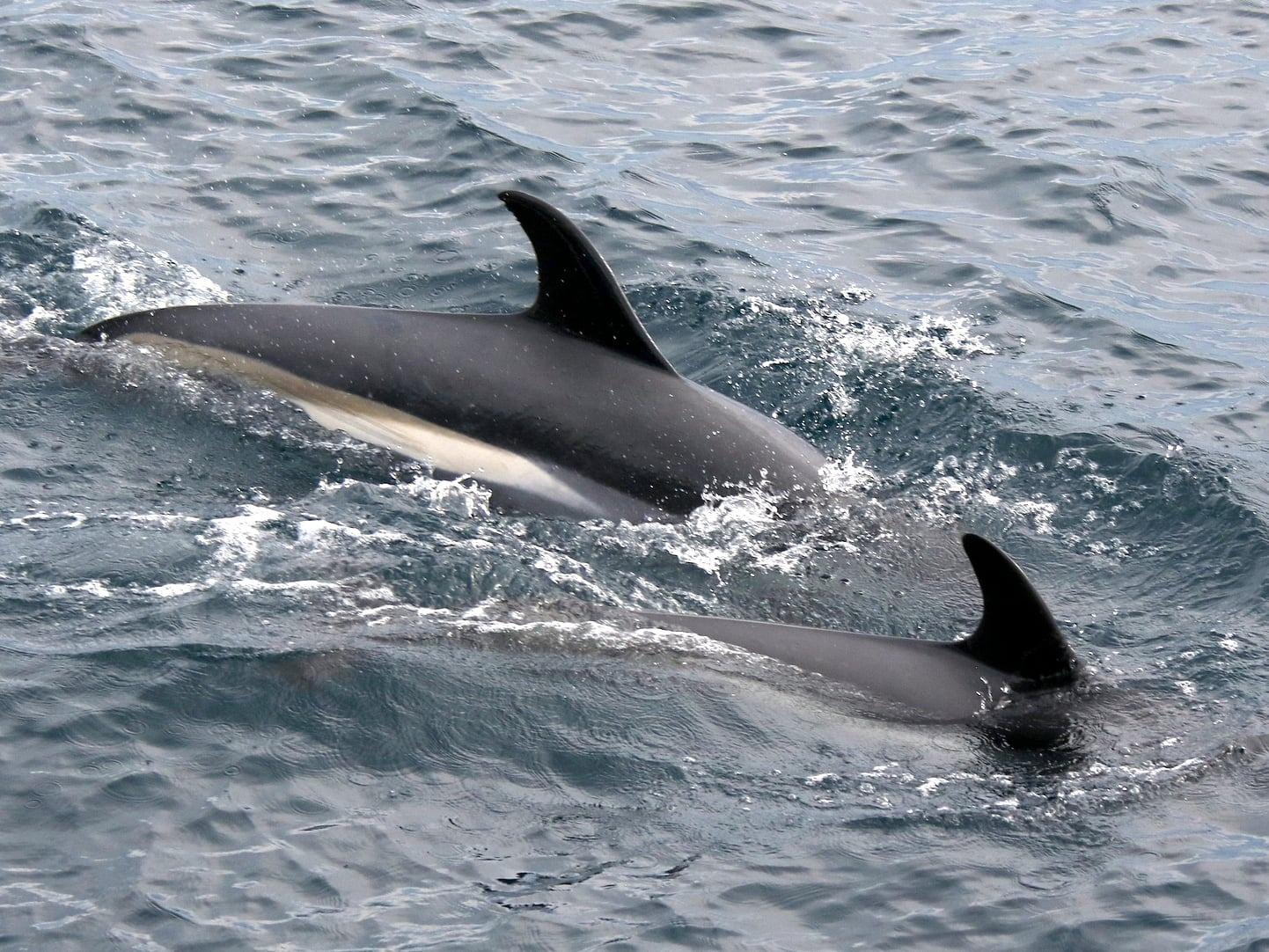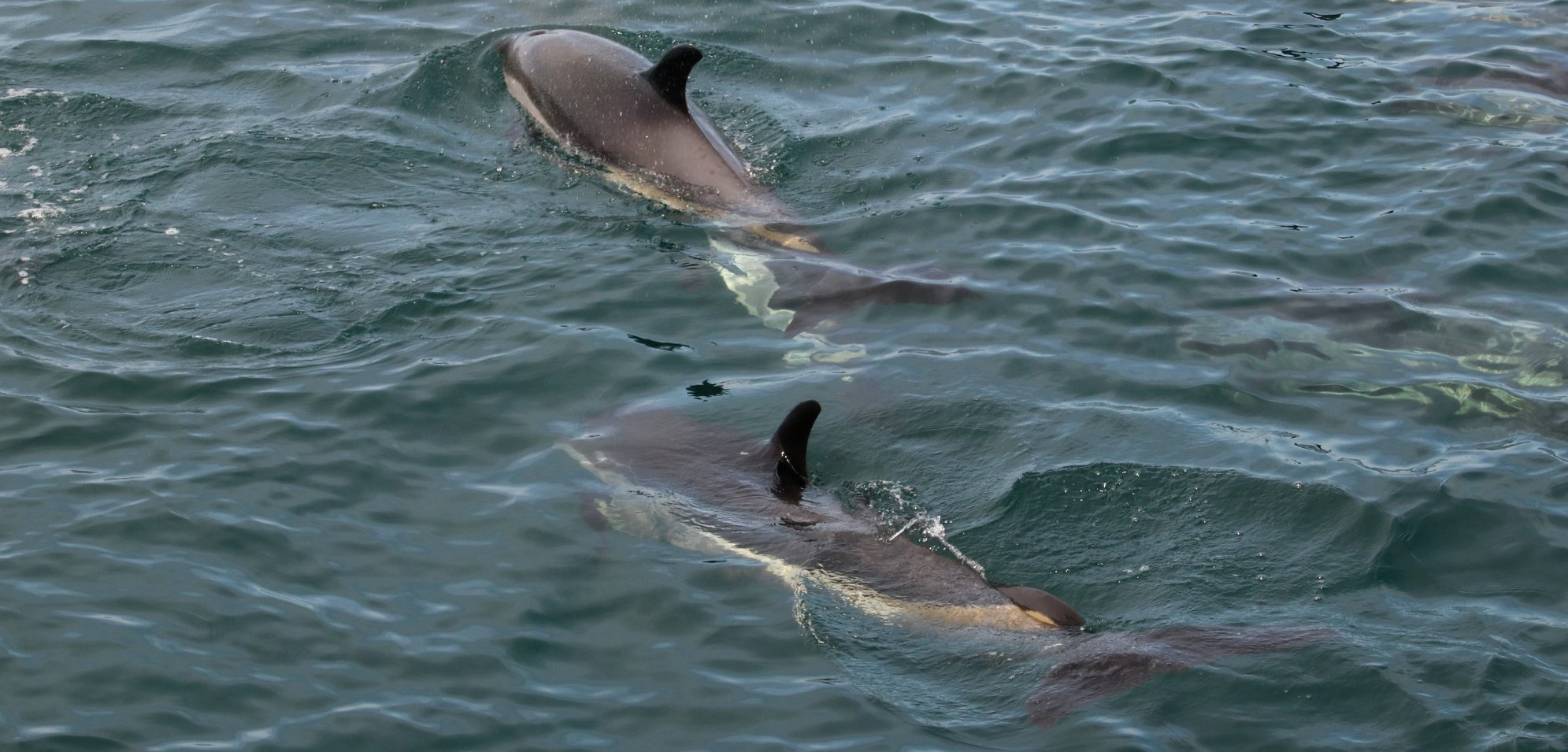- Order:Cetacea
- Suborder:Odontoceti
- Family:Delphinidae
- Genus:Lagenorhynchus
- Species:Lagenorhynchus acutus (Gray, 1828)
Identification
The Atlantic white-sided dolphin (Lagenorhynchus acutus) is a medium-sized, robust and conspicuously coloured dolphin. It has a tall, strongly falcate dorsal fin (located in the middle of the back), and a gently sloping forehead and short stubby beak, defined from the melon by a deep crease. The tail stock is very thick (particularly in males), narrowing abruptly close to the flukes, often with a thick, distinctive keel above and below the tail stock. The flippers are dark in colour, sickle-shaped, and have pointed tips and the tail flukes have strongly concave trailing edges and a shallow median notch.
These dolphins have a distinctive colouring and pattern. The back is black or dark purple to grey, and the dark colouring extends from the posterior section of the beak to the tail. There is a yellow to tan ventral blaze along each side of the tail stock behind the dorsal fin. This extends upwards towards the ridge of the tail stock and a mid-lateral white band on the flank below the dorsal fin. Below the dark dorsal zone is a pale grey stripe along the length of the body. The belly is pale, yellowish cream and there are large black genital blazes. There is a dark stripe between the corner of the jaw and the anterior insertion of the flippers, which joins the large dark eye patch.
The dolphin is a fast swimmer, known to exhibit exuberant behaviour, breaching and lob tailing, to smack the water with their tails and sometimes bow-ride.
Distribution & Habitat
The Atlantic white-sided is only found in cool waters (average 7 to 12 degrees centigrade) of the North Atlantic Ocean. The species is generally considered to be a pelagic, offshore species, often frequenting the continental shelf edge, although white-sided dolphins may be seen close to shore and can sometimes mass-strand (photo of one of six animals that mass stranded in Brora, Scotland last year, below left).
Sightings off the British Isles indicate that the species is relatively common, particularly along the continental shelf slope west of the Atlantic coast of Ireland and Scotland, and north of the Northern Isles (Shetland and Orkney). The species has been recorded as far south as the Iberian Peninsular and the Bay of Biscay. Off the British Isles, there are indications of a northward movement from the North Sea east of Shetland and Orkney in late autumn, but sightings are concentrated between June and November.

Natural History & Ecology
Adult white-sided dolphins are up to 243 cm (females) and 267 cm in length (males) (average length is about 250 cm) and weigh 182 kg and 234 kg respectively. Female white-sided dolphins generally attain sexual maturity at a length of about 201 to 210 cm and age of 6 to 12 years. Males attain sexual maturity at a length of about 210 to 244 cm and 8 to 9 years of age. The calving season is in summer and has been calculated to be between May and August, with a peak in June and July in the north-west Atlantic, and probably between April and July off the British Isles. The gestation period is about 11 months and the lactation period is estimated to last about 18 months.
These dolphins are thought to feed in small groups, preying on small schooling fish and squid. In the western North Atlantic, short-finned squid, herring, smelt, silver hake and shrimp have been found in the stomach contents of several animals. Off western Ireland, herring, mackerel and silvery pout were identified from stomachs of animals which mass-stranded. Surface feeding has been rarely observed.
Social Behaviour
White-sided dolphins have been observed in small groups of 6 to 30 animals off the United States and Britain, but seem to commonly form larger pods of up to 1,000 animals offshore. Within mature reproductive herds there is a high ratio of females to males, and it is possible that some males form separate 'bachelor' herds. Immature animals of both sexes, from 2 to 5 years old, leave the breeding natal herd after weaning, travelling alone or in loosely organised groups.
This species has been observed associating with other many other cetaceans, including white-beaked dolphins, long-finned pilot whales, fin whales, northern bottlenose whales, sperm whales, common dolphins, striped dolphins and humpback whales.

